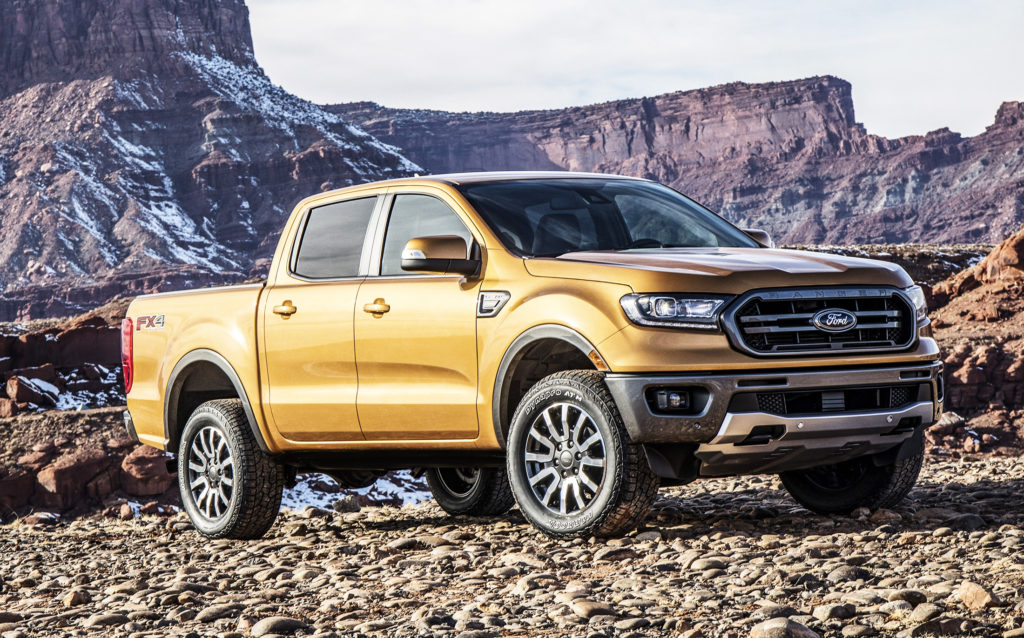Cargazing
By Derek Price
If you still think of the Ford Ranger as a small, simple, inexpensive truck, you’ll be in for a surprise when you drive the new one.
After taking a seven-year hiatus, the Ranger is back, if only in name. This resurrected version is so much bigger, pricier, more capable and more refined now that it feels like an ever-so-slightly scaled-down version of the F-150.
While technically considered a mid-size truck — designed to compete with the old guard of Toyota Tacoma and Nissan Frontier like before, but also the fresh Chevrolet Colorado and GMC Canyon rivals — the new-generation Ranger drives almost like a full-size pickup.
It’s priced like one, too. The Ranger starts at $24,300, within spitting distance of the F-150’s $28,155 base price. Options on my tester pushed the window sticker over $40,000, something that seems to leave room at the bottom of the market for an even smaller, more stripped-down truck that actually resembles the Ranger of yesteryear.

The new Ford Ranger looks and feels similar to a downsized F-150. It has much more room, capability and refinement compared to the old truck that bore its name.
For now, this is the smallest Ford pickup you can get. For people who don’t need the F-150’s bigger size and appetite for fuel but still need to do real work — including towing up to 7,500 pounds or hauling 1,860 pounds of payload — the Ranger checks the right boxes.
It does so in a thoroughly modern way, too, starting with its powertrain.
A turbocharged 2.3-liter, four-cylinder engine is mated to a spectacularly well-sorted 10-speed automatic transmission to deliver smooth acceleration, quick response and effortless shifts. Everything under the hood feels like it was stolen from a pricey car, even if the solid rear axle with leaf springs makes it clearly a truck on bumpy roads.
The optional Sync 3 infotainment system on my tester was easy to use through its 8-inch touchscreen. Other snazzy upgrades include dual-zone climate control, push-button start, adaptive cruise control, lane-keeping assist, Ford’s Blind Spot Information System, and a Bang & Olufsen-branded sound system with 10 speakers.

An optional eight-inch touchscreen running the third generation of Ford’s Sync interface makes the new Ranger feel contemporary.
Automatic emergency braking with pedestrian detection comes standard on all trims.
While I liked the overall layout of my SuperCrew Lariat test truck, including the roominess up front and a back seat that is reasonably specious for adults, I wasn’t as wild about the material choices considering this is the top trim of an all-new truck for the U.S. market. Heavy reliance on hard plastics makes the cabin already feel dated in places.
A pleasant surprise was the Ranger’s supple ride. It feels smooth and softly sprung, a good match for highway cruising.
An available FX4 Off-Road package is a better fit for driving off the pavement. Its Terrain Management System and Trail Control, skid plates and an electronic transfer case mean you can drive straight from the dealer to the trails, if that’s your thing.
Ford also is offering the ever-popular blacked-out trim group for a custom, sinister appearance. With its wonderfully straightforward name, the recently announced Black Appearance Package comes with a black grille, running boards, wheels, mirrors, fender vent surrounds and more, something that helps bright colors such as Lightning Blue paint scream even louder.
So far, around two-thirds of Ranger buyers are opting for an appearance package, Ford claims. Other choices include the Chrome Appearance Package with lots of shiny bling and the Sport Appearance Package with an accent color called “Magnetic.”
At A Glance
What was tested? 2019 Ford Ranger Lariat SuperCrew ($34,385). Options: Trailer tow package ($495), 501A package ($1,795), sport appearance package ($895), 18-inch aluminum wheels ($895), spray-in bedlinen ($495). Price as tested (including $1,195 destination charge): $40,155
Wheelbase: 126.8 in.
Length: 210.8 in.
Width: 77.8 in.
Height: 71.1 in.
Engine: 2.3-liter EcoBoos four cylinder (270 hp, 310 lbs.-ft.)
Transmission: 10-speed automatic
Fuel economy: 21 city, 26 highway
RATINGS
Style: 8
Performance: 9
Price: 5
Handling: 6
Ride: 8
Comfort: 8
Quality: 7
Overall: 8
Why buy it?
It can do serious work, including towing up to 7,500 pounds, but has a more appealing size, price and fuel economy compared to full-size trucks.
